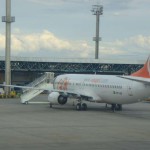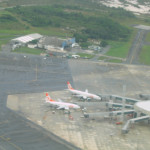GOL Linhas Aéreas Inteligentes S.A. , Brazil’s low cost airline, released preliminary passenger statistics for the month of February 2009.
São Paulo – Domestic passenger traffic (RPK) for February 2009 decreased 5.1% and capacity (ASK) decreased 2.7% year-over-year (vs. February 2008). Domestic load factor for the month was 60% and international load factor was 51%. GOL’s total system load factor for the month of February was 59%.
|
Consolidated Operating Data |
February 2009 * |
February 2008 * |
Change (%) |
|
Total System |
|||
|
ASK (mm) (1) |
2,932.8 |
3,554.2 |
-17.5% |
|
RPK (mm) (2) |
1,721.7 |
2,122.6 |
-18.9% |
|
Load Factor (3) |
58.7% |
59.7% |
-1.0 p.p. |
|
Domestic Market |
|||
|
ASK (mm) (1) |
2,465.8 |
2,533.3 |
-2.7% |
|
RPK (mm) (2) |
1,483.8 |
1,564.3 |
-5.1% |
|
Load Factor (3) |
60.2% |
61.7% |
-1.5 p.p. |
|
International Market |
|||
|
ASK (mm) (1) |
467.0 |
1,020.9 |
-54.3% |
|
RPK (mm) (2) |
237.9 |
558.3 |
-57.4% |
|
Load Factor (3) |
50.9% |
54.7% |
-3.8 p.p. |
( * ) February 2009 – preliminary data; final data for February 2008. (1) Available seat kilometers represents the aircraft seating capacity multiplied by the number of kilometers the seats are flown. (2) Revenue passenger kilometers represents the numbers of kilometers flown by revenue passengers. (3) Load factor represents the percentage of aircraft seating capacity that is actually utilized (calculated by dividing revenue passenger kilometers by available seat kilometers).





